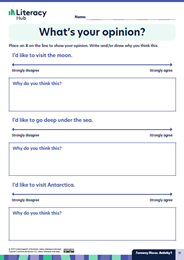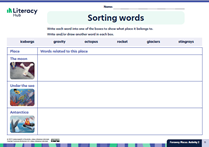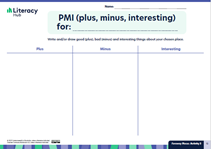Faraway Places
This poem describes three amazing and wondrous places. The narrator of the poem is an adventurous girl who talks about what she would see and do if she visited these places: the moon; deep under the sea; and the cold, icy world of Antarctica.
Back to the shared reading overview page
Text download
Faraway Places as PDF (5.9MB) (opens in new window)
Faraway Places as PowerPoint slideshow (9.9MB) (download)
Printable worksheets
|
|
|
|

Teaching & learning sequence
This teaching and learning sequence outlines classroom strategies for Faraway Places, including:
- ways to incorporate the ‘Big Six’ core elements of reading development
- fun, engaging and adaptable student activities for a diverse range of abilities
- links to the Australian Curriculum.
| Text features | Cross-curriculum links to the Australian Curriculum |
|
|

First read
As a whole group, enjoy sharing the text and learning together.
Engage
Encourage students to use their imagination. Close your eyes and imagine you are on the moon. What would you see? What would it feel like? What would you be thinking? Have students turn and talk to a partner. Encourage students to share their ideas and use these to fill in a large see/think/feel Y-chart.
Repeat the activity asking students to imagine they are deep under the sea and then imagine they are in Antarctica (you may need to explain that Antarctica has a freezing cold climate and land that is mostly covered in ice). Fill in a separate see/think/feel Y-chart for each place, and retain these to use again later.
Tell the students that you are going to share a poem about these three interesting and faraway places.
Read aloud
Read the first verse of Faraway Places with rhythm and expression, and then discuss the imagery and mood of the poem. What images or pictures did you ‘see in your mind’ as I read the poem aloud? How did the poem make you feel?
Read the other two verses and discuss in a similar manner.
Make meaning
Support students in making meaning through a class discussion. Who is ‘the speaker’ or narrator of the poem? Discuss and draw out that the girl in the illustrations is narrating the poem – it is her thoughts and words. Do you ever imagine visiting interesting, faraway places like this girl does? What faraway place would you like to visit? Allow time for students to share their thoughts and ideas.
Reread verse one and then revisit the see/think/feel Y-chart created earlier. What new ideas would you like to add to our chart? Scribe further ideas the students might have onto the chart.
Repeat with the other two verses.
Revisit the text
Return to the text several times to look more closely at different aspects of its content, structure and language features. This is a great vehicle for exploring the ‘Big Six’ of literacy in an integrated way, with all components linking to the same text.
Comprehension
Reading is about making meaning. Choose from these comprehension activities to help your students explore the text deeply, make personal connections, develop new understandings, and draw conclusions. The activities will also help students analyse the text, think critically about it and form their own opinions.
Talking text types (whole-group activity)
Discuss the text type and its purpose. What sort of text is Faraway Places? How do you know this? Discuss what makes a poem a poem. Draw out that most poems have a rhythm. Highlight and model the rhythm of Faraway Places. Explain that some poems have words, phrases or whole lines that are repeated.
Talk about the rhyming words in Faraway Places. Which words rhyme? Discuss and draw out that each verse has three sets of rhyming words. Work with the students to identify these words. Explain that not all poems have rhyming words.
What is the purpose of a poem? Discuss and draw out that a poem is written to entertain people, to provide enjoyment, to share feelings, thoughts and ideas. Some poems can teach us things or contain a message. What did you learn by hearing this poem? Discuss.
Have students reflect on the poem’s meaning and messages, and the author’s point of view. What does the poem say about our world? What do you think the author’s opinion of the world is?
Australian Curriculum links
Viewing the visuals (whole-group activity)
Revisit each verse of the poem and ask students to focus on the illustrations. How do the illustrations add to the poem? What do they show us that isn’t written in the text? What do they tell us about the girl? Discuss as a group.
Australian Curriculum links
What’s your opinion? (independent activity)
Pose the questions: Which place written about in the poem would you most like to visit and why? Is there a place that you wouldn’t you like to visit? Why? Have students discuss the questions in small groups.
Write the statement ‘I’d like to visit the moon’ on a chart. Underneath the statement draw a continuum line with the label ‘strongly disagree’ on one end, and the label ‘strongly agree’ on the other end (see example below). Mark an X on the line to show your opinion. Think aloud as you explain your reasons for having this opinion, and write about it on the chart.

Introduce the What’s your opinion? worksheet, and have students complete it. After students complete their worksheets, have them talk about them in small groups.
Print the What’s your opinion? worksheet.
Australian Curriculum links
Put yourself in the picture (independent activity)
Encourage students to make personal connections with the poem. What place or places would you love to visit and why? Have students share their opinions and justify them.
Have students draw a picture of themselves in their chosen amazing, wondrous place. Encourage them to imagine being there and what they might see and do. Students could write about their picture by completing the sentence starter: I’d like to visit …
Students can share their finished pictures with the group and explain why they chose the places they did.
Australian Curriculum links
Phonological awareness (including phonemic awareness)
These activities will help students to hear the sounds and rhythms of language. Guide them as they explore syllables, onset and rime and listen for phonemes – the smallest units of sound within a word. Use the activities to help your students identify the phonemes in words and practise blending, segmenting and manipulating these sounds.
Rhyming words (whole-group activity)
Use the poem to focus on hearing rhyming words. Read the first two lines (the first sentence) of the first verse and ask students to listen for the words that sound similar – the words that rhyme. Can you hear the words that have the same sound at the end? The rhyming words? (‘day’, ‘way’). What sound do they have that is the same? (-ay making the long a sound). Do you know other words that have the -ay sound at the end? (e.g. play, bay, may, lay, stay).
Repeat with some or all of the other pairs of rhyming words in the poem (explore/soar, place/space, see/free, too/blue, know/go, see/sea, around/abound, fun/sun).
Australian Curriculum links
Phoneme fun (whole-group activity)
Use the rhyming words ‘fun’ and ‘sun’ to focus on hearing individual phoneme in words. Ask students to identify the sounds they hear in the word ‘sun’ (s, u, n). What would the word sound like if we took away the s sound and replaced it with the f sound? Ask pairs of students to experiment with adding other initial phonemes (sounds) to the -un sound (bun, run, gun, nun, won). Have pairs share their ideas.
Repeat with other rhyming words such as ‘day’ and ‘way’ focusing on the long a ending, or ‘know’ and ‘go’ to focus on the long o sound at the end of the words.
Australian Curriculum links
Phonics
Evidence shows that children learn best about the relationship between phonemes and graphemes when instruction occurs through a daily structured synthetic phonics program (also known as systematic synthetic phonics). Knowing about these relationships will help students to decode, and this is crucial for their continued reading development.
In addition to your phonics program it is helpful to expose students to letter–sound relationships they come across in other contexts, such as during shared reading experiences. Choose activities that are relevant to your students so they can practise and reinforce already learnt concepts, so as to build automaticity in recognising letter–sound relationships.
Matching letters to sounds (whole-group activity)
Use rhyming words in the poem to reinforce letter–sound correspondences already learnt by your students. For example, you could focus on the long a sound in the words 'day' and 'way'. Write these words on a chart and underline the letters that make the long a sound (day, way). List other words that end in the long a sound (stay, play, prey, grey, tray).
Repeat with other rhyming pairs that reinforce phonics concepts your students have learnt (explore/soar, place/space, see/free, too/blue, know/go, see/sea, around/abound, fun/sun).
Australian Curriculum links
Exploring digraphs (partner activity)
Reinforce the concept of a digraph – when two letters represent one sound. Revisit the poem and identify consonant digraphs that your students have learnt, and list these on a chart (e.g. rocket, there, than, fish, other, sting, much).
Have pairs write the word and highlight the digraph they are focusing on. Have them draw a picture to represent their word, and list two or three other words with the same digraph.
Display the digraph cards in the classroom as a reference.
Australian Curriculum links
Oral language
Oral language development begins at birth, and having a rich oral language is beneficial as a foundational and ongoing resource for literacy development. Oral language is embedded throughout the shared reading experience as students listen and respond to quality texts.
It is also valuable to involve students in specific activities that will continue to improve their oral language skills. Choose from these activities to help students develop and practise important communication skills.
Retelling (small-group activity)
Have students work in groups of three. Each student takes turns to retell one verse of the poem by explaining where the girl in the poem went, and what she did and saw there. Encourage students to use active listening skills such as looking at the speaker, nodding and sitting upright to show interest.
Be aware of the language demands on English as an additional language or dialect (EAL/D) students and culturally and linguistically diverse (CALD) students when orally retelling. If required, give extra support to students by guiding them through the retelling as part of a teacher-led focus group.
Australian Curriculum links
Convince me! (partner activity)
Have students work with a partner to create an oral presentation that convinces the rest of the class that they should visit a particular place. The place could be one of the places written about in the poem, or somewhere else chosen by the students. Encourage students to include at least two strong reasons why it would be an interesting or fun place to visit.
Pairs can practise their presentations and then present to the class.
Australian Curriculum links
Fluency
Activities aimed at teaching and practising fluency are important for students on their journey towards becoming independent readers. Explicitly modelling fluency and providing opportunities for students to practise reading aloud are integral to this.
Act it out! (small-group activity)
Model reading the poem with fluency, expression and rhythm. As you read, invite two or three students to act out each verse. Encourage them to listen to what is being described in the poem, and act accordingly.
Alternatively, students might like to work in groups and have some students read the poem aloud as others in the group act it out. Small groups can practise their performances and present to the whole group.
Australian Curriculum links
Echo reading (whole-group activity)
Explain that you would like the students to repeat each line (or sentence) of the poem after you read it to them. Listen to my voice and the rhythm I read with, and then be my echo! Read the first line of the poem aloud with rhythm and fluency. Have the students repeat the line after you.
Continue ‘echo reading’ throughout the poem.
Note: this poem is presented using sentence punctuation, with an upper-case letter at the beginning of each sentence and a full stop or exclamation mark at the end. Poems can also be written with upper-case letters at the beginning of each line, and occasionally they are even written without punctuation.
Australian Curriculum links
Readers theatre (small-group activity)
Provide small groups of students with one verse of the poem each. Have them practise reading the poem as a group. Encourage them to use clear voices and to read with fluency and expression.
Have each group read their verse of the poem to the whole class.
Australian Curriculum links
Vocabulary
Having a rich, broad vocabulary assists students when they are tackling new texts. These vocabulary activities will help them to build their growing bank of words.
The activities introduce students to new Tier 2 and Tier 3 words, as well as exploring word families and a range of different word types.
Identifying sight words (whole-group activity)
Read the first two lines (the first sentence) of the poem slowly as you point to each word that you say. What words do you recognise in these first two lines? Invite students to say and point to words they know such as ‘like’, ‘to’, ‘the’, ‘off’, ‘in’, ‘my’ and ‘so’.
Continue by reading two lines (or a sentence) at a time and stopping to ask students to view the words closely and identify the sight words they know.
Australian Curriculum links
Homophones (whole-group activity)
Revisit the third verse and read the first two lines aloud. What do you notice about the last word in each line? Discuss and draw out that both words sound the same but they are spelt differently and they have different meanings (‘see’ and ‘sea’).
Introduce other common homophones to the group such as ‘know’ and ‘no’, ‘hear’ and ‘here’, ‘buy’ and ‘bye’, ‘for’ and ‘four’, and ‘eye’ and ‘I’.
Homophones can be tricky, especially for EAL/D students, so where required give extra support by explaining the meaning of each word, and saying it in a sentence.
Australian Curriculum links
Nouns and verbs (whole-group activity)
Use the poem as a vehicle to explore nouns and verbs. Refer to the first verse. Explain that a noun is a word that refers to a person, a place or a thing. What nouns are mentioned in this verse? Use students’ ideas to write a class list (moon, rocket, gravity, outer space). Explain that some nouns are things that cannot be seen such as ‘gravity’. Discuss other abstract nouns such as ‘love’, ‘hope’, ‘fear’ and ‘pride’.
Discuss what a verb is, and draw out that a verb is a word that describes what is happening, such as an action. What actions does the girl do in this verse? Again, use students’ ideas to create a list on a chart (‘fly’, ‘speed off’, ‘land’, ‘jump out’, ‘explore’, ‘leap’, ‘soar’, ‘see’). Explain that all of these words are verbs.
Repeat the activity with the other two verses and continue to add words to each list.
Australian Curriculum links
Topic words (partner activity)
Explore the verses one at a time to identify and list words that are related to the place the verse is about. What words are related to the moon? Use students’ responses to list the words (moon, gravity, rocket).
Discuss the meaning of each word. Ask students to take turns saying each of the words in a sentence to their partner. Invite a student to draw an image that represents the word onto the chart.
Repeat with the other two verses (Under the sea – octopus, stingrays, green turtles, fish; and Antarctica – glaciers, icebergs, penguins, seals).
Have students work with a partner to complete the Sorting words printable worksheet.
Print the Sorting words worksheet.
Australian Curriculum links
Fish in a school (whole-group activity)
Pose the question: What is a school? Discuss and then draw students’ attention to the word ‘schools’ in verse two. What does the word ‘schools’ mean here? Discuss and draw out that the word ‘school’ can also be used to label a group of fish. Have students turn to a partner and take turns saying the word ‘school’ in sentences. Encourage them to use it in different contexts to show its different meanings.
Discuss other collective nouns that name groups of animals such as a herd of cows, a flock of sheep, a swarm of bees, a pride of lions, a litter of puppies and a pack of wolves.
Australian Curriculum links
Reflecting on learning
Help students ‘bring it all together’ and reflect on their understandings by completing a graphic organiser either independently or with a partner.
PMI chart
Talk about each place the girl visited: the moon, under the sea, and Antarctica. What are the positive things about visiting this place? What wouldn’t be good? What things do you find interesting about this place? Have students choose one of the places depicted in the poem to analyse. Have them write and/or draw about this place in the PMI (plus, minus, interesting) chart.
Print the PMI (plus, minus, interesting) chart.
For families - new for 2024!Reinforce your classroom learning by telling families in your class about Faraway Places. Families can share the text at home and use the information provided to build knowledge and instill a love of reading. |


